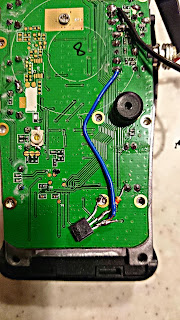Building small and light repeater, I came across a problem of getting carrier detect signal from a Baofeng BF-888 radio. I like this radio so I didn't want to drill any holes in it for additional wire.
Looking at a pinout of plug used for external speaker and programming I found one unused pin - tip of the 3,5mm jack. For unknown reason there is a 3V voltage on this pin and you can draw up to 50mA from it.
Probably some more expensive external microphones use it for their amplifiers.
This voltage is also present on a Wouxun KG-UVD1 radio I own (looking at the service manual you can see circuit providing it). This is probably some kind of standard for Kenwood type connector used in most cheap Chinese radios. This is even referenced by some companies selling those:
Anyway - when receiving a transmission, you don't need a microphone amplifier, right? :). So my idea was to ground this pin every time radio opens its squelch.
When it comes to BF-888, to get carrier detection status you need to use one of the IC pins from the back of a PCB. Unfortunately, connector socket pins are from the front side of a board. I didn't want to drill a hole in a PCB to lead a wire between its sides, so using a multimeter I found a solution :). One of the pins visible at the bottom of a board (the one with resistor soldered by me) is used to power an audio amplifier.
To conserve power, amplifier is powered up only when radio receives a transmission and opens its quelch (CTCSS and DCS settings are of course validated before).
My circuitry is trivial - using 5kOhm resistor, power from audio amplifier enables BC547 transistor and grounds tip of the radio connector - voltage on the connector drops from 3V to 0V. Squelch closes, radio disables audio amplifier and shuts down transistor. Voila :)
This technique has one drawback - radio enables audio amplifier also when generates sounds by itself - beeping when battery is low, etc. You need to be aware of it - if this is a problem for you, consider disabling internal sounds when programming your radio. Or drill a small hole in a PCB and get real carrier detect signal from the back side.
Have fun.
BF-888 radio carrier detect circuitry

